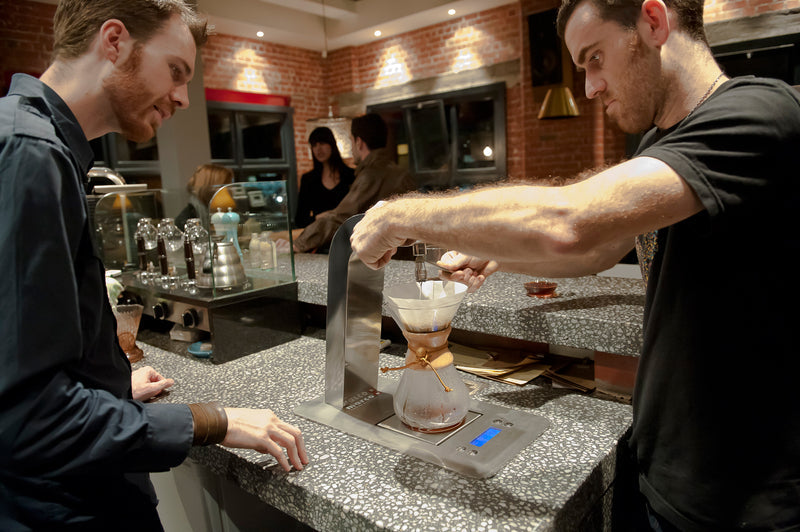 Do you remember the days where ‘going out for a coffee’ was a real treat? It was made more special if the cafe had the skill to whip the milk in such a way that they were able to make an Everest-like peak on their ‘Cap-oh-cheeeno’. Do you remember the days when we were willing to fork out our hard earned shekels for nearly anything that was made by the ‘Cap-oh-cheeeno’ machine? Those days were awesome, but it’s probably more awesome now that those days are over.
Do you remember the days where ‘going out for a coffee’ was a real treat? It was made more special if the cafe had the skill to whip the milk in such a way that they were able to make an Everest-like peak on their ‘Cap-oh-cheeeno’. Do you remember the days when we were willing to fork out our hard earned shekels for nearly anything that was made by the ‘Cap-oh-cheeeno’ machine? Those days were awesome, but it’s probably more awesome now that those days are over.
It’s been interesting to compare what cafes offered back then with what they offer now. Here is my précis of the order of the events:
Cafes offer coffee made on espresso machines. During this era, it didn’t really matter what coffee and it didn’t really matter how it was made.
Cafes offer branded coffee made on espresso machines. During this period it’s all about the brand, the espresso machine the coffee roasting companies gave them and how many umbrellas, cups, aprons and how much signage came bundled with the coffee. It was important to realise how much all of this ‘stuff’ made you look like a ‘serious cafe’.
Then, in the early 2000’s, tons of things changed. A different type of cafe emerged onto the market. These cafes valued different things. They didn’t care about branding, umbrellas, cups and the cheap machines on offer for free from the coffee roasting companies. What they wanted was fresh roasted specialty coffee made on good equipment by well trained, passionate people — and they were willing to pay for it.
Some of them lifted the price of their cups of coffee to better represent the quality they were offering and the additional (and significant) cost paid by them to achieve this higher quality. Some of the pioneers of the increased prices were slammed by the news media, but it appeared that what they were offering had already won the respect and appreciation of the discerning coffee-drinking public. If anything, the media attention, which was intended to be negative, had the opposite effect. The upshot of all of this is that by the end of the 2000’s, consumers were getting a much better product than they were before, and they were happy to pay for it.
We are now in the 20teens and are again witnessing a surge of café owners wanting to deliver yet another round of improvements to their coffee offering. Much of the world’s Arabica comes from growers with very small levels of production. Historically, this coffee has been sold to mill/exporters who then load it into their vast silos, blend it in with all the other small lots and sell the blended result by the container load to everyone around the world. The main difference now is that cafe owners are collaborating much more closely with roasters, and roasters are collaborating more closely with the growers — mainly for the purpose of providing the end consumer with an opportunity to taste and enjoy specific coffee from specific growers.
Achieving this is not easy. Firstly, one of the main reasons for offering micro lot coffee is for it to showcase the potential of a particular region — meaning that it’s all a waste of time and effort if the coffee isn’t excellent and doesn’t reflect the characteristics you might expect from the geographical location, growing conditions and processing methods. This needs people on the ground working with the grower to make sure that they are employing the best agricultural and processing practices possible, and that their coffee, once ready for sale, is kept aside from the rest of the tons of coffee going into mill/exporter production lines and is hulled, bagged and shipped separately as small, individual lots.
All of this costs a great deal. The labour inputs are much higher. For example, farmers need to employ more pickers over a longer period of harvest to ensure that they are only picking ripe cherries. The labour inputs are much higher for the mill, as they need to handle the small lots manually and keep the coffee off the automated hulling lines. This separate handling of the coffee continues all the way through the process right through to the cup.
I really enjoy walking into a cafe knowing that I have an opportunity to order a single origin, micro lot coffee. I must admit that I’m sometimes guilty of taking a choice of a micro lot for granted. As an insider, I know what additional costs have gone into taking coffee from the tree of a particular farmer and I love knowing that it’s the very same coffee in the hopper I’m about to order from.
Celebrate the grower and their efforts by ordering a micro lot single origin when you have the chance. Celebrate the cafe owner who has also gone to the effort and expense of giving you the bean.
It’s all about the coffee.



